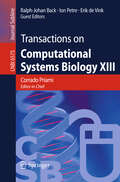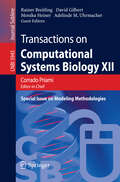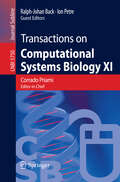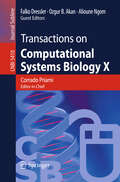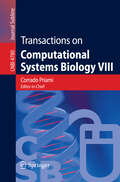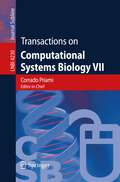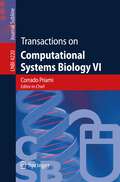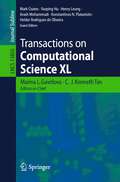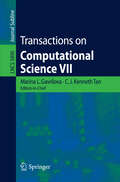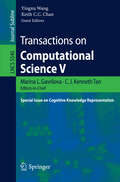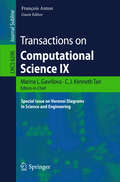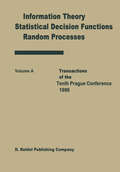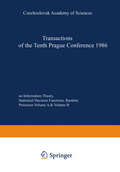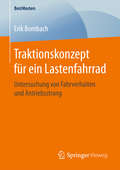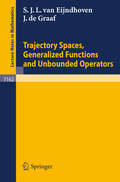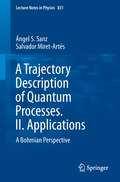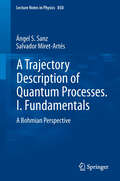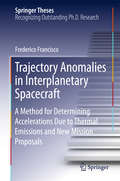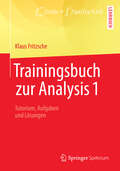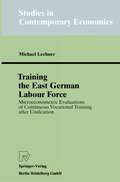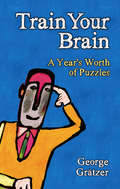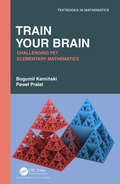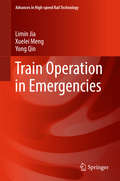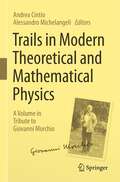- Table View
- List View
Transactions on Computational Systems Biology XIII (Lecture Notes in Computer Science #6575)
by Corrado PriamiThe LNCS journal Transactions on Computational Systems Biology is devoted to inter- and multidisciplinary research in the fields of computer science and life sciences and supports a paradigmatic shift in the techniques from computer and information science to cope with the new challenges arising from the systems oriented point of view of biological phenomena. This, the 13th Transactions on Computational Systems Biology volume, guest edited by Ralph-Johan Back, Ion Petre, and Erik de Vink, focuses on Computational Models for Cell Processes and features a number of carefully selected and enhanced contributions initially presented at the CompMod workshop, which took place in Eindhoven, The Netherlands, in November 2009. From different points of view and following various approaches, the papers cover a wide range of topics in systems biology, addressing the dynamics and the computational principles of this emerging field.
Transactions on Computational Systems Biology XII: Special Issue on Modeling Methodologies (Lecture Notes in Computer Science #5945)
by Rainer Breitling Corrado Priami David Gilbert Monika Heiner Adelinde UhrmacherTransactions on Computational Systems Biology XI: Computational Models for Cell Processes (Lecture Notes in Computer Science #5750)
by Ralph-Johan Back Ion PetreTransactions on Computational Systems Biology X (Lecture Notes in Computer Science #5410)
by Falko Dressler Ozgur B. Akan Alioune Ngom Corrado PriamiTechnology is taking us to a world where myriads of heavily networked devices interact with the physical world in multiple ways, and at many levels, from the globalInternetdowntomicroandnanodevices. Manyofthesedevicesarehighly mobile and autonomous and must adapt to the surrounding environment in a totally unsupervised way. A fundamental research challenge is the design of robust decentralized c- puting systemsthat arecapableofoperating in changing environmentsandwith noisy input, and yet exhibit the desired behavior and response time, under c- straints such as energy consumption, size, and processing power. These systems should be able to adapt and learn how to react to unforeseen scenarios as well as to display properties comparable to social entities. The observation of nature has brought us many great and unforeseen concepts. Biological systems are able to handle many of these challenges with an elegance and e?ciency far beyond currenthumanartifacts. Basedonthisobservation,bio-inspiredapproacheshave been proposed as a means of handling the complexity of such systems. The goal is to obtain methods to engineer technical systems, which are of a stability and e?ciency comparable to those found in biological entities. This Special Issue on Biological and Biologically-inspired Communication contains the best papers from the Second International Conference on Bio- Inspired Models of Network, Information, and Computing Systems (BIONET- ICS 2007). The BIONETICS conference aims to bring together researchers and scientistsfromseveraldisciplines incomputerscienceandengineeringwhereb- inspired methods are investigated, as well as from bioinformatics, to deepen the information exchange and collaboration among the di?erent communities.
Transactions on Computational Systems Biology VIII (Lecture Notes in Computer Science #4780)
by Corrado PriamiThe LNCS journal Transactions on Computational Systems Biology is devoted to inter- and multidisciplinary research in the fields of computer science and life sciences. It supports a paradigmatic shift in the techniques from computer and information science to cope with the new challenges arising from the systems oriented point of view of biological phenomena. The six papers selected for this special issue cover a broad range of topics.
Transactions on Computational Systems Biology VII (Lecture Notes in Computer Science #4230)
by Corrado PriamiThis volume, the 7th in the Transactions on Computational Systems Biology series, contains a fully refereed and carefully selected set of papers from two workshops: BioConcur 2004 held in London, UK in August 2004 and BioConcur 2005 held in San Francisco, CA, USA in August 2005. The 8 papers chosen for this special issue are devoted to various aspects of computational methods, algorithms, and techniques in bioinformatics.
Transactions on Computational Systems Biology VI (Lecture Notes in Computer Science #4220)
by Corrado PriamiThe 5th Transactions on Computational Systems Biology volume, edited by Gordon Plotkin, features carefully selected and enhanced contributions initially presented at the 2005 IEEE International Conference on Granular Computing. The 9 papers selected for this special issue discuss various aspects of computational methods, algorithm and techniques in bioinformatics such as gene expression analysis, biomedical literature mining and natural language processing, protein structure prediction, biological database management and biomedical information retrieval.
Transactions on Computational Science XL (Lecture Notes in Computer Science #13850)
by Marina Gavrilova C. J. Kenneth Tan Mark Coates Yaoping Hu Henry Leung Arash Mohammadi Konstantinos N. Plataniotis Helder Rodrigues de OliveiraThe LNCS journal Transactions on Computational Science reflects recent developments in the field of Computational Science, conceiving the field not as a mere ancillary science but rather as an innovative approach supporting many other scientific disciplines. The journal focuses on original high-quality research in the realm of computational science in parallel and distributed environments, encompassing the facilitating theoretical foundations and the applications of large-scale computations and massive data processing. It addresses researchers and practitioners in areas ranging from aerospace to biochemistry, from electronics to geosciences, from mathematics to software architecture, presenting verifiable computational methods, findings, and solutions, and enabling industrial users to apply techniques of leading-edge, large-scale, high performance computational methods.This, the 40th issue of the Transactions on Computational Science, is a special issue, comprised of seven papers, and devoted to the developing and novel techniques for Trustworthy Technologies for Autonomous Human-Machine Systems. They include emerging and innovative applications of computer security-based applications, as well as theoretical contributions that are relevant to Trustworthy Technologies for Autonomous Human-Machine Systems.
Transactions on Computational Science VII (Lecture Notes in Computer Science #5890)
by C. J. TanThe LNCS journal Transactions on Computational Science reflects recent developments in the field of Computational Science, conceiving the field not as a mere ancillary science but rather as an innovative approach supporting many other scientific disciplines. The journal focuses on original high-quality research in the realm of computational science in parallel and distributed environments, encompassing the facilitating theoretical foundations and the applications of large-scale computations and massive data processing. It addresses researchers and practitioners in areas ranging from aerospace to biochemistry, from electronics to geosciences, from mathematics to software architecture, presenting verifiable computational methods, findings and solutions and enabling industrial users to apply techniques of leading-edge, large-scale, high performance computational methods. The 7th issue of the Transactions on Computational Science journal is devoted to core computational science techniques, such as grid computing, advanced numerical methods, and stochastic systems. It has been divided into two parts. The five papers in Part I focus on computations of stochastic systems and the four papers in Part II focus on computational methods for complex systems.
Transactions on Computational Science V: Special Issue on Cognitive Knowledge Representation (Lecture Notes in Computer Science #5540)
by C. J. TanThe LNCS journal Transactions on Computational Science reflects recent developments in the field of Computational Science, conceiving the field not as a mere ancillary science but rather as an innovative approach supporting many other scientific disciplines. The journal focuses on original high-quality research in the realm of computational science in parallel and distributed environments, encompassing the facilitating theoretical foundations and the applications of large-scale computations and massive data processing. It addresses researchers and practitioners in areas ranging from aerospace to biochemistry, from electronics to geosciences, from mathematics to software architecture, presenting verifiable computational methods, findings and solutions and enabling industrial users to apply techniques of leading-edge, large-scale, high performance computational methods. The fifth volume of the Transactions on Computational Science journal, edited by Yingxu Wang and Keith C.C. Chan, is devoted to the subject of cognitive knowledge representation. This field of study focuses on the internal knowledge representation mechanisms of the brain and how these can be applied to computer science and engineering. The issue includes the latest research results in internal knowledge representation at the logical, functional, physiological, and biological levels and describes their impacts on computing, artificial intelligence, and computational intelligence.
Transactions on Computational Science IX: Special Issue on Voronoi Diagrams in Science and Engineering (Lecture Notes in Computer Science #6290)
by Francois AntonThe 9th issue of the Transactions on Computational Science journal, edited by François Anton, is devoted to the subject of Voronoi diagrams in science and engineering. The 9 papers included in the issue constitute extended versions of selected papers from the International Symposium on Voronoi Diagrams, held in Copenhagen, Denmark, June 23-36, 2009. Topics covered include: divide and conquer construction of Voronoi diagrams; new generalized Voronoi diagrams or properties of existing generalized Voronoi diagrams; and applications of Voronoi diagrams and their duals in graph theory, computer graphics, bioinformatics, and spatial process simulation.
Transactions of the Tenth Prague Conferences: Information Theory, Statistical Decision Functions, Random Processes Volume A & Volume B (Transactions of the Prague Conferences on Information Theory #10A-B)
by J. A. VísekThe Conference was organized by the Institute of Information Theory and Automation of the Czechoslovak Academy of Sciences from July 7 - 11, 1986, in Prague. The round number of the conference was only one of the jubilees connected with its organization. Namely, thirty years of the Prague Conferences (the first one was organized in autumn 1956 in Liblice near Prague), and two anniversaries of Professor Anton1n Spacek, the inspirator and first organizer of the Prague Conferences - 75 years of his birth and 25 years of his untimely death. (More about Professor Spacek can be found in the Transactions of the Sixth Prague Conferen ce) • The Tenth Prague Conference kept the traditional style and orien tation typical for the previous Prague Conferences. Almost two hund red of participants from 23 countries (Algerie, Austria, Bulgaria, Canada, Czechoslovakia, Federal Republic of Germany, Finland, France, German Democratic Republic, Great Britain, Hungary, Iran, Italy, Ja pan, Netherlands, Poland, Roumania, Soviet Union, Sweden, Switzerland, United States, Vietnam and West Berlin) took part in its sessions and discussions. There were 14 invited lectures and . 92 short contri butions included in four parallel sections of the Conference program me: further, 12 contributions were presented as posters. The invited lectures and submitted contributions covered the three traditional subjects of the Prague Conferences introduced in their title, as well as lots of further applications of the probability theory and mathe matical statistics. Most of the presented lectures and contributions are published in the present Conference Transactions.
Transactions of the Tenth Prague Conference on Information Theory, Statistical Decision Functions, Random Processes: held at Prague, from July 7 to 11, 1986 (Transactions of the Prague Conferences on Information Theory #10A-B)
by J. A. VísekTraktionskonzept für ein Lastenfahrrad: Untersuchung von Fahrverhalten und Antriebsstrang
by Erik BombachErik Bombach untersucht anhand einer Simulink-Modellierung des Gesamtsystems Lastenpedelec verschiedene Antriebskonzepte und vergleicht diese primär an der Position des Motors miteinander. Zudem wird das Potential von Dualspeichern, Rekuperation und prädiktiver Motorregelung bewertet. Dabei wird die kinetische Simulation der Fahrdynamik sowie die Energetik verschiedener Lastfälle eingebunden. Der Autor beurteilt ebenfalls die Tauglichkeit eines Mehrmotorantriebes, welcher bis heute keine Anwendung in der Praxis findet. Dazu stellt er drei Betriebsstrategien vor, die bestimmen, wann welcher Motor wie viel Leistung erbringen muss. Seine Auswertung ergab, dass die optimale Motorposition vom Anwendungsgebiet des Lastenpedelecs abhängt. Das hergeleitete Modell hat durch seinen modularen Aufbau eine hohe Anpassungsfähigkeit und ist in den verschiedensten Anwendungen nutzbar.
Trajectory Spaces, Generalized Functions and Unbounded Operators (Lecture Notes in Mathematics #1162)
by Stephanus van Eijndhoven Johannes de GraafA Trajectory Description of Quantum Processes. II. Applications: A Bohmian Perspective (Lecture Notes in Physics #831)
by Ángel S. Sanz Salvador Miret-ArtésTrajectory-based formalisms are an intuitively appealing way of describing quantum processes because they allow the use of "classical" concepts. Beginning as an introductory level suitable for students, this two-volume monograph presents (1) the fundamentals and (2) the applications of the trajectory description of basic quantum processes. This second volume is focussed on simple and basic applications of quantum processes such as interference and diffraction of wave packets, tunneling, diffusion and bound-state and scattering problems. The corresponding analysis is carried out within the Bohmian framework. By stressing its interpretational aspects, the book leads the reader to an alternative and complementary way to better understand the underlying quantum dynamics.
A Trajectory Description of Quantum Processes. I. Fundamentals: A Bohmian Perspective (Lecture Notes in Physics #850)
by Ángel S. Sanz Salvador Miret-ArtésTrajectory-based formalisms are an intuitively appealing way of describing quantum processes because they allow the use of "classical" concepts. Beginning at an introductory level suitable for students, this two-volume monograph presents (1) the fundamentals and (2) the applications of the trajectory description of basic quantum processes. This first volume is focussed on the classical and quantum background necessary to understand the fundamentals of Bohmian mechanics, which can be considered the main topic of this work. Extensions of the formalism to the fields of open quantum systems and to optics are also proposed and discussed.
Trajectory Anomalies in Interplanetary Spacecraft: A Method for Determining Accelerations Due to Thermal Emissions and New Mission Proposals (Springer Theses)
by Frederico FranciscoThis thesis presents fundamental work that explains two mysteries concerning the trajectory of interplanetary spacecraft. For the first problem, the so-called Pioneer anomaly, a wholly new and innovative method was developed for computing all contributions to the acceleration due to onboard thermal sources. Through a careful analysis of all parts of the spacecraft Pioneer 10 and 11, the application of this methodology has yielded the observed anomalous acceleration. This marks a major achievement, given that this problem remained unsolved for more than a decade.For the second anomaly, the flyby anomaly, a tiny glitch in the velocity of spacecraft that perform gravity assisting maneuvers on Earth, no definitive answer is put forward; however a quite promising strategy for examining the problem is provided and a new mission is proposed. The proposal largely consists in using the Galileo Navigational Satellite System to track approaching spacecraft, and in considering a small test body that approaches Earth from a highly elliptic trajectory.
Trainingsbuch zur Analysis 1: Tutorium, Aufgaben und Lösungen
by Klaus FritzscheDie Mathematik gilt als schwierig, und ganz besonders die Analysis 1 wird von Studienanfängern als Stolperstein empfunden. Dabei bräuchten die meisten nur etwas mehr Anleitung und vor allem viel Übung, kurz, ein intensives Training. Dieses Buch bietet ein solches Training an.Der Aufbau orientiert sich am Grundkurs Analysis 1 des Autors, aber dank ausführlicher Literaturhinweise mit inhaltlichen Zuordnungen kann das Training Analysis 1 als Begleitung zu jedem gängigen Lehrbuch und jeder Analysisvorlesung erfolgreich eingesetzt werden.Auf eine Zusammenfassung der Theorie folgen in jedem Abschnitt Tutorien mit ausführlichen Erklärungen zu ausgewählten, wichtigen Themen. Danach werden zahlreiche durchgerechnete Beispiele und schließlich eine Reihe von Aufgaben mit mehr oder weniger ausführlichen Lösungshinweisen angeboten. Unterstützt wird das Ganze durch viele Illustrationen, und ein Anhang enthält ausführlich durchgerechnete Musterlösungen zu allen Aufgaben.
Training the East German Labour Force: Microeconometric Evaluations of continuous Vocational Training after Unification (Studies in Contemporary Economics)
by Michael LechnerAfter unification large amounts of money were spent to retrain the East Germany labour force in order to ease the transition to the new market economy. This book uses microeconometric methods and individual data to evaluate the impact of these training programmes on the participants' labour market situation. It discusses the appropriate evaluation methodology as well as the effectiveness of the actual programmes for the individual participants. The empirical results suggest that the public sector sponsored training programmes were fairly ineffective. In contrast, the training organized and paid by the enterprises caused considerable earnings growings.
Train Your Brain: A Year's Worth of Puzzles
by George GratzerMany people start the day with physical exercise but few seem to be so concerned with exercising the most human of organs-the brain. This book provides you with entertaining and challenging mental exercises for every week of the year. Whether you are a high school student eager to sharpen your brain, or someone older who would like to retain your m
Train Your Brain: Challenging Yet Elementary Mathematics (Textbooks in Mathematics)
by Bogumil Kaminski Pawel PralatThis accessible book helps readers to see the bigger picture of advanced mathematics. The book contains carefully selected, challenging problems in an easy-to-follow, step-by-step process. Neither prior preparation nor any mathematical sophistication is required. The authors guide the reader to “train their brain” to think and express themselves in a rigorous, mathematical way, and to extract facts, analyze the problem, and identify main challenges. A firm foundation in a diverse range of topics is presented. Moreover, the authors show how to draw appropriate, true conclusions. Computer support is used to better intuition into discussed problems. The book is designed for self-study. It can be used to bridge the gap between introductory calculus/linear algebra courses and more advanced courses offered at universities. It improves the ability to read, write, and think in a rigorous, mature mathematical fashion. The reader will develop a deeper understanding in preparation to succeed in more advanced course work. Features•The authors employ a six-step process: 1.SOURCE2.PROBLEM3.THEORY4.SOLUTION5.REMARK6.EXERCISES •An Appendix introduces programming in Julia This book is also suitable for high school students that are interested in competing in math competitions or simply for people of all ages and backgrounds who want to expand their knowledge and to challenge themselves with interesting questions.
Train Your Brain: Challenging Yet Elementary Mathematics (Textbooks in Mathematics)
by Bogumil Kaminski Pawel PralatThis accessible book helps readers to see the bigger picture of advanced mathematics. The book contains carefully selected, challenging problems in an easy-to-follow, step-by-step process. Neither prior preparation nor any mathematical sophistication is required. The authors guide the reader to “train their brain” to think and express themselves in a rigorous, mathematical way, and to extract facts, analyze the problem, and identify main challenges. A firm foundation in a diverse range of topics is presented. Moreover, the authors show how to draw appropriate, true conclusions. Computer support is used to better intuition into discussed problems. The book is designed for self-study. It can be used to bridge the gap between introductory calculus/linear algebra courses and more advanced courses offered at universities. It improves the ability to read, write, and think in a rigorous, mature mathematical fashion. The reader will develop a deeper understanding in preparation to succeed in more advanced course work. Features•The authors employ a six-step process: 1.SOURCE2.PROBLEM3.THEORY4.SOLUTION5.REMARK6.EXERCISES •An Appendix introduces programming in Julia This book is also suitable for high school students that are interested in competing in math competitions or simply for people of all ages and backgrounds who want to expand their knowledge and to challenge themselves with interesting questions.
Train Operation in Emergencies (Advances in High-speed Rail Technology)
by Limin Jia Xuelei Meng Yong QinThis book presents the latest findings on train operation theories and methods in the context of emergencies. It examines and assesses a range of aspects—including the definition of a railway emergency, transport organization modes in emergencies, calculating railway transport capacity in emergencies, line planning in emergencies, train re-pathing in emergencies and train re-scheduling in emergencies—that are urgently needed in the railway transportation field, which faces the serious challenge of dealing with emergencies worldwide. The book highlights the latest research results in an integrated and systematic way, and the methodology presented is oriented on real-world problems, allowing it to be used not only directly in railway operational management, but also as the point of departure for further applications or theoretical research. As such, the book will be of considerable interest to graduate students and researchers in the field of traffic and transportation engineering.>
Trails in Modern Theoretical and Mathematical Physics: A Volume in Tribute to Giovanni Morchio
by Andrea Cintio Alessandro MichelangeliThis book celebrates the life and work of the late Giovanni Morchio (1944–2021). It features scientific and anecdotal contributions written by his former colleagues, co-authors, and students, as well as senior scientists who were active witnesses to the dramatic advances in physics and in mathematics that took place during his 50-year-long career. The volume begins with a biographical introduction, detailing Giovanni Morchio’s life and his role as a physicist, mathematician, teacher, and scientist. The core of the book covers a vast spectrum of ideas, reflecting Dr Morchio’s scientific interests. Each chapter develops a specific topic of modern research, ranging from quantum mechanics and quantum field theory to additional themes such as the connection between general relativity and Newtonian gravitation. Every contribution provides a historical retrospective, a survey of advances, an outlook of future perspectives and challenges, and an updated bibliography. The last part collects the authors’ recollections of their professional and personal interactions with Dr Morchio, in recognition of his deep achievements, his exceptional pedagogical qualities, and his praiseworthy social and pro bono commitment. Authored by physicists of international calibre covering a broad range of subjects, the book will be a valuable reference for researchers and students of theoretical and mathematical physics.
